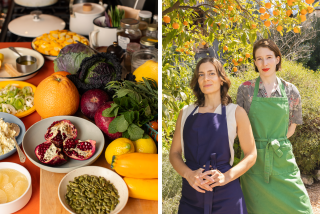No-Gimmick Vegetarianism
Most vegetarian cookbooks seem to be based on some high concept intended to make vegetarian cooking more appealing. “Vegetarian Food Like Your Mother Made.” “Vegetarian Dishes You Won’t Know Are Vegetarian.” “Vegetarian Cooking With Plenty of Fat.”
OK, these aren’t real titles, but they could be, given how unappetizing the word “vegetarian” seems to some. Even many who say they’re vegetarians stop short of being full vegetarians, instead calling themselves “semi-vegetarian” or “fish-etarian” (they eat fish but not meat).
The best vegetarian cookbooks--or any cookbooks, for that matter--needn’t bother twisting their titles to convince us of their merit. Deborah Madison’s “Vegetarian Cooking for Everyone” (Broadway Books, 1997), a thorough cookbook for meat eaters and non-meat eaters alike, is a good example. And Martha Rose Shulman’s new book, “The Best Vegetarian Recipes” (William Morrow, $25), is another. It has the kind of recipes you turn to for everyday cooking, without any gimmicks. (The title, though, does seem to draw a bit on the “best recipe” fad in cookbook publishing.)
Shulman, who writes that she began cooking vegetarian meals more than 25 years ago, presents 200 recipes that sound good at first glance. She doesn’t throw in less common ingredients such as soy this and that, as do many vegetarian books straining to be clever. Most of the recipes use everyday ingredients in dishes such as chilled beet soup, polenta with oyster mushrooms and chipotles and shells with zucchini, corn, beans and tomato sauce.
Sure there’s tofu, but how could “the best” vegetarian recipes not include it? When tofu is done right, even non-vegetarians clamor for it. Shulman devotes one of the nine chapters to tofu and includes recipes for marinades, stir-fries and a hot pot--a spicy stew of shiitake mushrooms, bell peppers, red chard and Asian chile paste.
Other chapters cover salads, soups, eggs and cheese, grains and beans, pasta and desserts. Aren’t most desserts vegetarian, you might ask? Well, probably, but the benefit here is Shulman’s workable recipes--apricot clafouti , cherry cobbler with cornmeal topping, citrus and date gratin. “My mother taught me long ago that guests might not remember anything else they ate at a dinner party,” she writes in the book’s introduction, “but they always, ‘especially the men,’ remember the dessert.”
I’ll second that.
A fair number of tips are spread throughout the book; one of the best is the advance preparation advice at the bottom of a recipe. The book begins with the typical “well-stocked” pantry suggestions and a few basic but solid thoughts on preparing vegetarian meals for entertaining. The tone of the tips is similar to that of the recipes: straightforward and accessible. Though some of the recipes might seem overly basic, such as shredded romaine salad or quesadillas, why quibble? After all, they are “the best,” according to the title, and to some extent, you have to go with the concept.
More to Read
Eat your way across L.A.
Get our weekly Tasting Notes newsletter for reviews, news and more.
You may occasionally receive promotional content from the Los Angeles Times.









